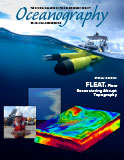Alford, M.H., R. Lukas, B.M. Howe, A. Pickering, and F. Santiago-Mandujano. 2011. Moored observations of episodic abyssal flow and mixing at station ALOHA. Geophysical Research Letters 38, L15606, https://doi.org/10.1029/2011GL048075.
Alford, M.H., J.B. Girton, G. Voet, G.S. Carter, J.B. Mickett, and J. M. Klymak. 2013. Turbulent mixing and hydraulic control of abyssal water in the Samoan Passage. Geophysical Research Letters 40(17):4,668–4,674, https://doi.org/10.1002/grl.50684.
Becker, J.J., D.T. Sandwell, W.H.F. Smith, J. Braud, B. Binder, J. Depner, D. Fabre, J. Factor, S. Ingalls, S.-H. Kim, and others. 2009. Global bathymetry and elevation data at 30 arc seconds resolution: Srtm30_plus. Marine Geodesy 32(4):355–371, https://doi.org/10.1080/01490410903297766.
Cusack, J.M., G. Voet, M. Alford, J.B. Girton, G.S. Carter, L.J. Pratt, K.A. Pearson-Potts, and S. Tan. 2019. Persistent turbulence in the Samoan Passage. Journal of Physical Oceanography, https://doi.org/10.1175/JPO-D-19-0116.1.
Dillon, T.M. 1982. Vertical overturns: A comparison of Thorpe and Ozmidov length scales. Journal of Geophysical Research 87(C12):9,601–9,613, https://doi.org/10.1029/JC087iC12p09601.
Freeland, H. 2001. Observations of the flow of abyssal water through the Samoa Passage. Journal of Physical Oceanography 31(8):2,273–2,279, https://doi.org/10.1175/1520-0485(2001)031<2273:OOTFOA>2.0.CO;2.
Gourestski, V., and K. Koltermann. 2004. WOCE Global Hydrographic Climatology. Berichte des BSH 35(1–52).
Gregg, M. C. 1999. Uncertainties and limitations in measuring ε and χT. Journal of Atmospheric and Oceanic Technology 16(11):1,483–1,490, https://doi.org/10.1175/1520-0426(1999)016<1483:UALIMA>2.0.CO;2.
Gregg, M.C. 2004. Small-scale processes in straits. Deep Sea Research Part II 51:489–503, https://doi.org/10.1016/j.dsr2.2003.08.003.
Gregg, M.C., E.A. D’Asaro, J.J. Riley, and E. Kunze. 2018. Mixing efficiency in the ocean. Annual Review of Marine Science 10:443–473, https://doi.org/10.1146/annurev-marine-121916-063643.
Kunze, E., J.F. Dower, I. Beveridge, R. Dewey, and K.P. Barlett. 2006. Observations of biologically generated turbulence in a coastal inlet. Science 313:1,768–1,770, https://doi.org/10.1126/science.1129378.
Lavelle, J.W., I.D. Lozovatsky, and D.C. Smith IV. 2004. Tidally induced turbulent mixing at Irving Seamount: Modeling and measurements. Geophysical Research Letters 31, L10308, https://doi.org/10.1029/2004GL019706.
McDougall, T.J., and P.M. Baker. 2011. Getting Started with TEOS-10 and the Gibbs Seawater Oceanographic Toolbox. SCOR/IAPSO WG127.
Moum, J.N., M.C. Gregg, R.-C. Lien, and M.E. Carr. 1995. Comparison of turbulence kinetic energy dissipation rate estimates from two ocean microstructure profilers. Journal of Atmospheric and Oceanic Technology 12(4):346–366, https://doi.org/10.1175/1520-0426(1995)012<0346:COTKED>2.0.CO;2.
Oakey, N.S. 1982. Determination of the rate of dissipation of turbulent energy from simultaneous temperature and velocity shear microstructure measurements. Journal of Physical Oceanography 12:56–271, https://doi.org/10.1175/1520-0485(1982)012<0256:DOTROD>2.0.CO;2.
Osborn, T.R. 1980. Estimates of the local rate of vertical diffusion from dissipation measurements. Journal of Physical Oceanography 10:83–89, https://doi.org/10.1175/1520-0485(1980)010<0083:EOTLRO>2.0.CO;2.
Osborn, T.R., and W.R. Crawford. 1980. An airfoil probe for measuring turbulent velocity fluctuations in water. Chapter 19 in Air-Sea Interaction: Instruments and Methods. F. Dobson, L. Hasse, and R. Davis, eds, Plenum Press.
Pawlak, G., and L. Armi. 1997. Hydraulics of two-layer arrested wedge flows. Journal of Hydraulic Research 35(5):603–618, https://doi.org/10.1080/00221689709498397.
Peters, H., M.C. Gregg, and J.M. Toole. 1988. On the parameterization of equatorial turbulence. Journal of Geophysical Research 93(C2):1,199–1,218, https://doi.org/10.1029/JC093iC02p01199.
Polzin, K.L., J.M. Toole, J.R. Ledwell, and R.W. Schmitt. 1997. Spatial variability of turbulent mixing in the abyssal ocean. Science 276(5309):93–96, https://doi.org/10.1126/science.276.5309.93.
Pratt, L.J. 1984. On nonlinear flow with multiple obstructions. Journal of the Atmospheric Sciences 41(7):1,214–1,225, https://doi.org/10.1175/1520-0469(1984)041<1214:ONFWMO>2.0.CO;2.
Pratt, L.J., G. Voet, A. Pacini, S. Tan, M.H. Alford, G.S. Carter, J.B. Girton, and D. Menemenlis. 2019. Pacific abyssal transport and mixing: Through the Samoan Passage versus around the Manihiki Plateau. Journal of Physical Oceanography 49(6):1,577–1,592, https://doi.org/10.1175/JPO-D-18-0124.1.
Reid, J.L., and P.F. Lonsdale. 1974. On the flow of water through the Samoan Passage. Journal of Physical Oceanography 4(1):58–73, https://doi.org/10.1175/1520-0485(1974)004<0058:OTFOWT>2.0.CO;2.
Roemmich, D., S. Hautala, and D.L. Rudnick. 1996. Northward abyssal transport through the Samoan passage and adjacent regions. Journal of Geophysical Research 101(C6):14,039–14,055, https://doi.org/10.1029/96JC00797.
Rudnick, D.L. 1997. Direct velocity measurements in the Samoan Passage. Journal of Geophysical Research 102(C2):3,293–3,302, https://doi.org/10.1029/96JC03286.
Sánchez-Garrido, J.C., G. Sannino, L. Liberti, J. Garcia Lafuente, and L.J. Pratt. 2011. Numerical modeling of three-dimensional stratified tidal flow over Camarinal Sill, Strait of Gibraltar. Journal of Geophysical Research 116(C12), https://doi.org/10.1029/2011JC007093.
Shay, T.J., and M.C. Gregg. 1986. Convectively driven turbulent mixing in the upper ocean. Journal of Physical Oceanography 16(11):1,777–1,798, https://doi.org/10.1175/1520-0485(1986)016<1777:CDTMIT>2.0.CO;2.
Thorpe, S.A. 1977. Turbulence and mixing in a Scottish Loch. Philosophical Transactions of the Royal Society of London A 286:125–181, https://doi.org/10.1098/rsta.1977.0112.
Voet, G., J.B. Girton, M.H. Alford, G.S. Carter, J.M. Klymak, and J.B. Mickett. 2015. Pathways, volume transport and mixing of abyssal water in the Samoan Passage. Journal of Physical Oceanography 45(2):562–588, https://doi.org/10.1175/JPO-D-14-0096.1.
Voet, G., M.H. Alford, J.B. Girton, G.S. Carter, J.B. Mickett, and J.M. Klymak. 2016. Warming and weakening of the abyssal flow through Samoan Passage. Journal of Physical Oceanography 46(8):2,389–2,401, https://doi.org/10.1175/JPO-D-16-0063.1.
Waterhouse, A.F., J.A. MacKinnon, J.D. Nash, M.H. Alford, E. Kunze, H.L. Simmons, K.L. Polzin, L.C. St. Laurent, O.M. Sun, R. Pinkel, and others. 2014. Global patterns of diapycnal mixing from measurements of the turbulent dissipation rate. Journal of Physical Oceanography 44(7):1,854–1,872, https://doi.org/10.1175/JPO-D-13-0104.1.
Wesson, J.C., and M.C. Gregg. 1994. Mixing at Camarinal Sill in the Strait of Gibraltar. Journal of Geophysical Research 99(C5):9,847–9,878, https://doi.org/10.1029/94JC00256.
Winters, K.B. 2016. The turbulent transition of a supercritical downslope flow: Sensitivity to downstream conditions. Journal of Fluid Mechanics 792:997–1,012, https://doi.org/10.1017/jfm.2016.113.

